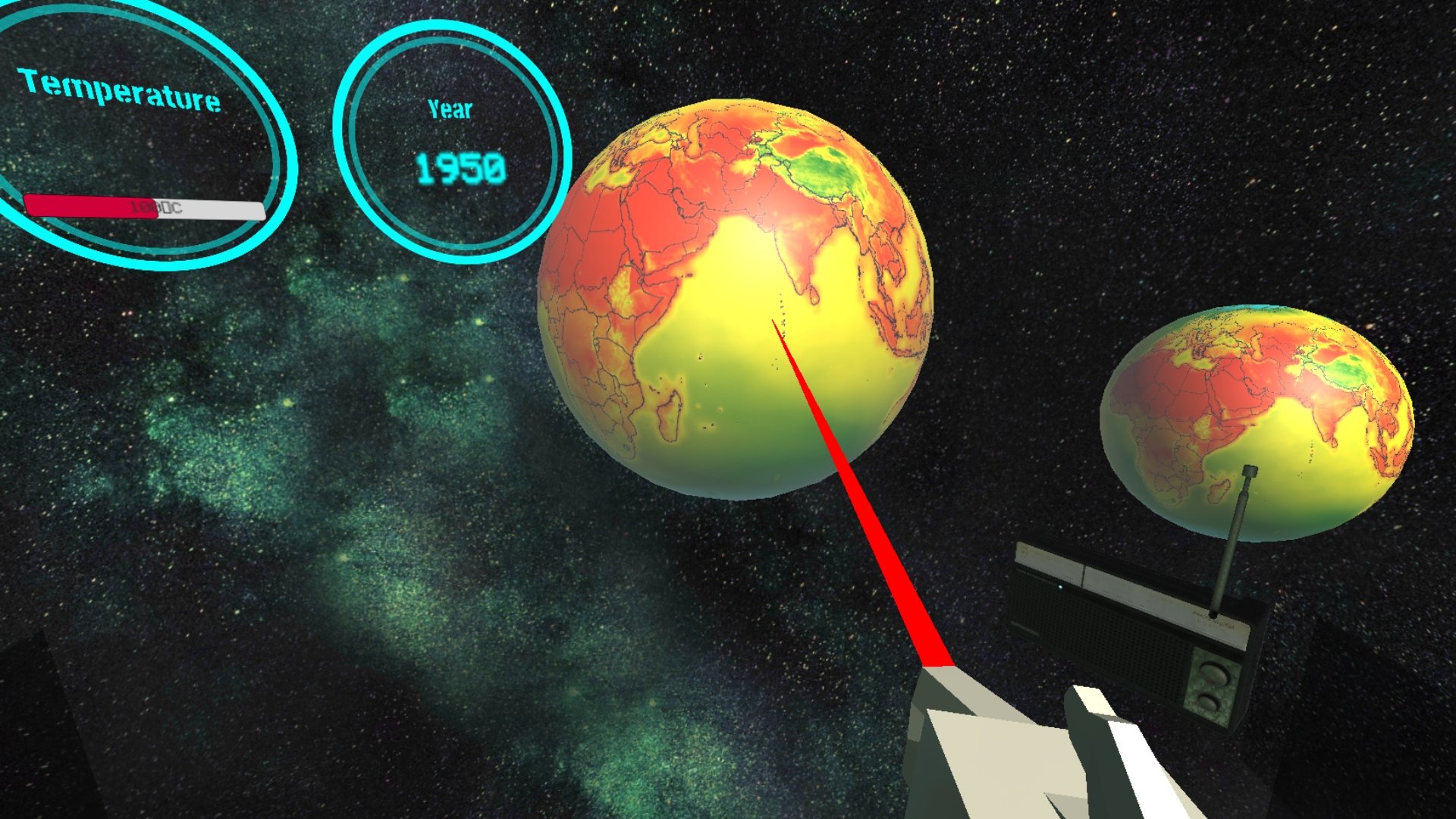Climavibe
About
Climavibe is a Virtual Reality simulation that tells the story of our climate future through the Overview effect. Users are transported to outer space from where they are given a front-row seat into the havoc that climate change will wreak.
Status:
In progress
Team Members
Michael Moyes: Unity 3D Lead + Scripting
Mark Mongilio: Music + SFX Lead
Karan Hallon: Storyboarding + Unity 3D
Hannah Munguia-Flores: Data Viz + Storyboarding
Luis Zanforlin: Mentor
Screenshots
Explanation
The Overview Effect, coined by Frank White in 1997, is recognized as the cognitive-shift experienced by astronauts in orbit as they take in planet Earth for all its pale-blue-dot glory [1]. Although this orbital perspective is only experienced by a few, the Overview Effect has been broken down by its four main stages experienced by the spacet-raveler: the overwhelming beauty of Earth, a sense of the fragility of the planet, registration of the interconnectedness of the planet, and a strong sense of concern and responsibility for Earth and its inhabitants.
The Overview Effect is often so transformative that many astronauts and space-travelers often devote the rest of their careers to environmental and climate work. Possible explanations for the Overview Effect include 1) Cognitive Dissonance (registered discordance between an observed reality and a perceived reality which requires accommodation through a complete cognitive shift) 2) Transcendence and Awe which leads to “small-self” perception and feelings of connectedness to our home planet. [2]
Many authors, poets, philosophers, and artists have tried to relay this orbital perspective to humans in order to elicit a sense of connection and stewardship for planet Earth. For example, architect and author Buckminster Fuller presented a framework for environmental advocacy in which humans are mere astronauts on-board Spaceship Earth. In his famous 1964 lecture, Fuller is quoted as saying:
I’ve often heard people say, ‘I wonder what it would feel like to be on board a spaceship,’ and the answer is very simple. What does it feel like? That’s all we have ever experienced. We are all astronauts. [3]
Similarly early NASA data from this vantage-point has similarly been used as an emotional trope in environmental movements:
The Apollo Mission photographs of earthrise and the Earth in space, for example, were quickly taken up by the US environmental community as normative signs, both demonstrating the Earth’s vulnerability, and calling on us to be responsible for it. [4]
While these descriptions of seeing Earth from a different perspective have merit, they often don’t elicit similar long-term reactions as the Overview Effect. For this reason, Virtual Reality can be leveraged to create a more embodied experience of Earthgazing and making the Overview Effect a more tangible experience for generating climate action.
The goal of this project was to create a virtual installation of the Overview Effect and present climate temperature historical and predicted data. When the user first puts on the headset, they see a virtual Earth through the visual spectrum. This was done by placing a floating exocentric globe in front of the viewer which allowed for a spacewalk-type Earthgazing experience which has been recorded as eliciting the strongest Overview Effect [2]. We allowed for free gameplay where the user could spin and play with the globe to create a sense of self relevance and create a personal connection with the planet in front of them. Additionally, we placed the user in a star skybox to create a sense of vastness which is recognized as important to elicit the Overview Effect.
Once the user starts the simulation, the visual spectrum globe changes to present temperature data. This data was collected and processed through Google Earth Engine, a cloud-based geospatial analysis platform to create a video to overlay on the virtual globe as a texture. The temperature data collection for the video consisted of 1950-2006 historical temperature data and 2007-2099 simulated temperature data. This data was derived from the NASA Downscaled global CMIP 5 simulations using the NCAR model.. This image collection consisting of daily temperature maps between 1950-2099 was then averaged out to create one frame or world map per year.
The climate change video was accompanied by a survey of musical styles through the decades, as another layer to assist with time scale. The user is further engaged with the experience because of the nostalgic aspects of each genre. To further the message, the music also intentionally goes from upbeat and happy-go-lucky, to dark and intense. As a final tone change, the soundtrack shifts to a non-musical soundscape of interference and old radio samples. This was done in order to help show the desolation of the future, and a world where music may not even exist.
In its current form, the APK is not a fully fleshed out version of our project. Our biggest challenge right now is being unable to use the project ever since we transferred our project over to the Universal Render Pipeline. This yields no build errors, nor does it yield Unity errors, but somehow Pico is unable to handle it.
References
[1] The Overview Effect: Space Exploration and Human Evolution, Third Edition (no date) Library of Flight. Available at: https://arc.aiaa.org/doi/abs/10.2514/4.103223 (Accessed: 18 November 2021).
[2] Frontiers | Space—A Virtual Frontier: How to Design and Evaluate a Virtual Reality Experience of the Overview Effect | Digital Humanities (no date). Available at: https://www.frontiersin.org/articles/10.3389/fdigh.2019.00007/full (Accessed: 24 October 2021).
[3] Anker, P. (2007) ‘Buckminster Fuller as Captain of Spaceship Earth’, Minerva, 45(4), pp. 417–434. doi:10.1007/s11024-007-9066-7.
[4] Jasanoff, S. (2010). A New Climate for Society. Theory, Culture & Society, 27(2–3), 233–253. https://doi.org/10.1177/0263276409361497





